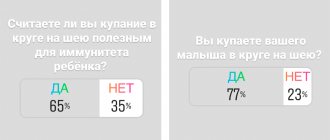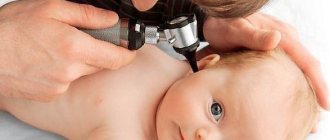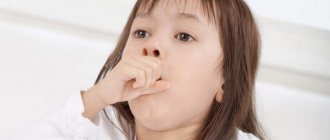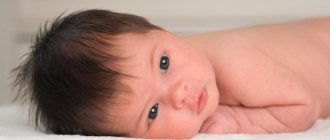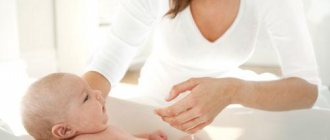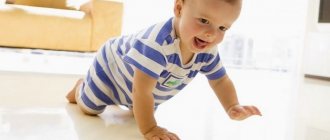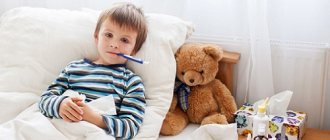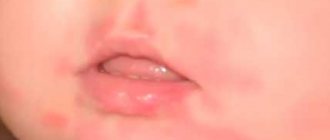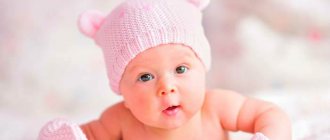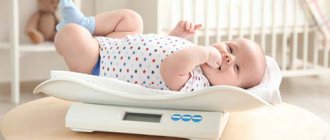Bathing a baby after one year
11 November 2013 admin Home page » Hygiene and health
After the first year of the baby’s life, it is already clear whether the child loves to bathe or performs it as a necessary daily ritual. Let's take a closer look at this topic specifically for children after one year. So, bathing a child after a year.
Most often, in the first months of their lives, children are afraid of water, afraid to swim, cry, and break out. And thank God if this goes away over the months and bathing turns into a favorite pastime and “oh horror” if it doesn’t. In general, for a more positive bathing experience and in order to instill a love for evening procedures, special slides for washing children, swimming rings for babies, various toys, foams, salts, etc. have not been invented. You and I know that it is good for the skin of babies to bathe them in baths with herbal decoctions, and for the little ones, everything with that same potassium permanganate.
But how does a child bathe after a year? And this happens much more fun and more consciously. Children at this age spend quite a lot of time in the bathroom; they love to frolic in the water, blow on the foam, ride a boat or splash around. For a more comfortable time in the water and for safety, you can purchase special seats for children. They are attached with Velcro to the bottom of the bathtub, looking like a regular seat with sides. The child is comfortable in them and the butt does not slip.
The closer we get to 1.6 years of age, the more confident children feel in the water, they no longer need seats and they don’t need parents (ours climbs out of the seat, removes our hands and does what he wants), we parents can only watch carefully and if something happens, catch an independent toddler, as well as protect the faucet and shower from the attacks of the young tester.
In general, bathing a child at 1 year and after a year is not so different from previous bathing. It is also possible, and in some cases necessary, to bathe children in herbal decoctions, chamomile, string, oak bark. In such a bath with herbs, redness disappears, the skin becomes ennobled, wounds heal, if any, in general, a therapeutic effect is ensured.
Bathing a child in herbs brings them calm and improves their well-being. Well, the most favorite thing for all kids is foam. When choosing foam for bathing, pay attention to what age they are made for, also look at “with tears” or “without tears.” For small children, it is best to buy both foam and tear-free shampoos.
To help your child fall asleep better, bathe him in warm water, never hot, you can add lavender-scented foam, lavender is very soothing. Although, if you spend a whole hour in the bathroom, the child will bathe himself so much that without any herbs he will quickly fall asleep and “without hind legs.”
Bathing a child after a year provides relief for parents, namely, it is no longer necessary to bathe the child every day, as is the case with newborns. You can safely do this every other day, every other day, and every day you can simply carry out the mandatory water procedures.
Watch our video below in more detail and visually, if you have any questions or additions, write, we will definitely discuss, but for now, enjoy your children with light steam and a wet bottom! And let every bath bring joy to your little ones, and satisfaction and happiness to you!
You can also read on this topic:
Children's winter hats
Diaper rash in infants
Morning in a large family.
Tags: to help mom, to help parents, Child health, baby development, Infant sleep
Do you need to bathe your baby every day?
According to many professionals, excessive use of water washes away the protective film from the child’s skin, the skin becomes drier, redness and peeling appear.
Moreover, in families that strive for sterile conditions for their baby, diseases manifest themselves more often, especially allergic diseases.
Therefore, Russian pediatricians advise bathing children under 6 months of age no more than once a day, or even less often.
Considering that babies hardly get dirty, washing and rinsing is enough. There are wet wipes for hands and face, and to prevent diaper rash, you need to make sure that the baby does not lie in a wet diaper.
We take a bath daily
This can be done as early as 2-3 months, says Evgeny Komarovsky. At first, a child can get comfortable in a large expanse of water with a circle around his neck. This is a special inflatable device with a recess for the chin and Velcro on the back of the neck. The baby is fixed in such a circle, his head is always above the water, and he can practice swimming on his back, stomach, and turning over on his own in the water. Usually this picture brings the baby’s parents into indescribable delight.
You can swim without a circle. For this, Evgeny Komarovsky recommends three poses:
The baby is completely immersed in water, leaving only his face on the surface. At the same time, it is supported by the index fingers under the neck. There is nothing dangerous about getting water into your ears and eyes, says the doctor. The main thing is that water does not get into your nose and mouth. Even if the baby takes a sip of it, nothing bad will happen.
In this position, the baby can be rolled from side to side.
The baby is imprisoned. Komarovsky claims that even newborns can sit in water perfectly.
Evgeniy Olegovich believes that a baby can even be taught to swim in a large bathtub. A newborn can dive quite successfully. At the same time, he cannot choke, since he reflexively “closes” the airways. If parents did not practice diving from birth, then by the age of 2-3 months this innate skill in the baby fades away. If you don't succeed in swimming, don't despair. Everything will come in due time.
If conditions allow, then it is good if the child takes a bath every day. In order for this to be done willingly, the child must be allowed to open the taps, regulate the temperature of the water and its quantity in the bath (about 36.5-37.5 ° in winter and 35-36 ° in summer). Pouring with cold water and a “shower” (cold or warm) is arranged only with the consent and desire of the child.
Do not use caustic soap or alkaline solutions, as this will irritate the skin. It is best to use “fat” soaps; they wash cleanly and do not destroy the thin layer of lubricant that covers the skin.
When the child sits in a bathtub with water, you need to let him stretch out freely in the water. Then he is thoroughly soaped (older children can do this themselves). Use a nail brush to clean your fingers and toes. From the age of 4, a child is taught to use a washcloth; it hardens the skin and makes it soft. Begin to wash carefully, from the shins to the knees and back, as these are the least sensitive areas.
How to cut a child's hair
Children under 4 years of age should not be allowed to have long hair. Regarding boys, this goes without saying. But as for girls, this already means a certain sacrifice. Until the age of 4, children's hair is very thin, fragile and easily tangled. When you comb a child, like it or not, some of the hair gets pulled out.
Girls should not have a ponytail, because hair collected and tied with an elastic band begins to thin, becomes thin at the temples and around the forehead, and becomes like fluff. Thin hairs cannot grow back; they are diseased hairs. If a girl wears a ponytail for a long time, her hair will never be thick and strong. Girls who wear their hair in a parting should change its place after each wash.
Hair should be cut in the direction in which it grows. The back of the head and behind the ears should not be cut with a clipper right down to the skin.
When combing your hair, you should choose a brush made of bristles or horsehair (not plastic or nylon). The child's head is combed every evening to remove dust from the hair. Pass the brush in all directions along each strand, and finally comb it in accordance with the natural direction of the hair.
Water temperature for washing hair
After your child turns 2 years old, you can use shampoo to wash your hair. However, we should not forget that prolonged and frequent use of it can make your hair dry and brittle. Most children, as a rule, have normal hair (not dry or oily), and low-quality shampoos can give undesirable results.
The water temperature for washing your hair should be moderately warm, never hot. The shampoo is diluted with water in a glass and used in two doses. Washed hair is rinsed well several times. Wipe with a dry, warm towel, without rubbing or tugging. You can dry with a hand-held hairdryer set to medium heat. To maintain a beautiful hair color, you can rinse with Chamomile infusion after washing.
Air, sun and movement are the factors that are of paramount importance for hardening the child’s body. We must do everything possible to ensure that the child, especially preschool age, spends as much time in the fresh air as possible.
Plants have a good effect on children; flowers, branches with leaves that a child can touch, have such an attractive force and cause such satisfaction that it is difficult to explain. Tumbling in the grass is one of the most enjoyable activities for a baby. Shells, stones, glass, chestnuts, acorns - everything has a deep meaning and constant, enduring value for a child (they are different from flowers and branches that break and wither).
It is not easy to satisfy a child’s love for animals. Children often ask to walk near the yard where they know there are animals (dog, cat, poultry). The train station, airport, and fountains are of particular interest to children.
Until how many months should I bathe my baby every day?
In general, the international recommendations are as follows: up to six months, children are bathed daily, from 6 months to a year - every other day, and after a year, once every two or three days is sufficient.
If the purpose of bathing is a hardening effect, then you need to bathe every day.
After the newborn is discharged, it is important to monitor the umbilical wound, so bathing in the first 10–15 days should be done very carefully.
At this age, it is enough to wipe the baby and give him air baths. If the child was born premature, then bathing should be postponed until recommended by the supervising doctor.
Preparation
Your baby should have everything he needs for a pleasant bath. Mom and Dad need to take care of this in advance. Even during pregnancy, parents usually purchase the necessary equipment. You shouldn’t throw money down the drain and buy a lot of unnecessary things – for example, several sets of rubber toys for playing in the water. The most necessary things, according to Komarovsky, are:
- Bath. Even if you really want to immediately start practicing bathing in a large bathtub or joint water procedures, Evgeniy Olegovich advises buying an ordinary small children’s plastic bathtub and using it for the first 2-3 months of the child’s life. There are several reasons: a child is more comfortable in a small space, it is easier to fill a small bathtub with warm water, even if there is no hot water supply, and it is easier to wash and keep clean than a large bathtub, which is used not only by the baby, but by the whole family.
- Water thermometer. At first, parents will need it so as not to make a mistake with the water temperature that is optimal for water procedures for a newborn. A little later, mom and dad will understand which water the child likes best and will be able to do without this device. However, the thermometer may come in handy later if the parents decide to harden the child, and Komarovsky strongly recommends doing this to everyone without exception. Now there are toy thermometers on sale (plastic giraffes, snakes and other characters). They can be great fun for your baby as he begins to play mindfully during his evening bath time.
- Soap. You should buy special baby soap. However, Komarovsky does not recommend using it often. The doctor believes that it is enough to bathe the child with soap 1-2 times a week. You should not buy sponges and washcloths, since the baby’s skin is very delicate and vulnerable. Evgeny Olegovich considers the best option to soap your own hand and easily wipe the child’s skin. If you really want to lather with something, then it is better to give preference to special mittens for bathing babies. It’s time for newfangled and advertised “tearless” products to appear on the bathroom shelf a little later. In the first couple of months of life, the child does not need such gels and shampoos.
- Towel. The child must have his own towel. A waffle or terry bath towel is not suitable for a baby. You need to choose a very soft product of a large size so that the baby can be wrapped in it from head to toe. Komarovsky draws attention to textile dyes, which can be quite allergenic for a baby’s delicate skin. It is better to give preference to white or light-colored towels made from natural fabrics (without dyes at all).
- Slide or hammock. This is a convenient device for bathing when you don’t have an extra pair of hands. If there is no help and is not in sight, bathing the baby using a plastic slide or a hanging hammock that is attached to the edges of the baby bathtub will not be difficult.
We suggest you familiarize yourself with Askoril on which day it helps
What to do if a child does not like to wash and screams?
Such situations do occur, says Komarovsky. But the point here is not at all about the child and not even about the fact that he is afraid of something. Most likely, according to a famous pediatrician, bathing conditions should be adjusted. Maybe the water temperature does not suit the baby - it is too high or too low for him.
For example, a mother tries to bathe her baby only at night, and it is at this time that the child wants to sleep and not bathe. Therefore, Komarovsky gives some advice that will help parents whose children have trouble in the water:
We invite you to familiarize yourself with Masks for dry mature skin
Change the time of day.
Change your eating and bathing routine. If your baby screams when bathing half an hour after eating, then try bathing him half an hour before eating (or vice versa).
Practice sharing baths with your baby.
Walk outside
Time spent by a child in the fresh air also has the advantage that he is constantly moving, and this develops and strengthens the muscles of the whole body. Legs develop best when a child runs on uneven terrain. To prevent flat feet, the child should walk barefoot or in shoes with thin soles for several hours.
It is recommended that children wear closed shoes (but not boots) with flexible soles, not too loose, but not too tight. Any shoes should have a certain length to make walking easier. It is not recommended to wear pumps; they are too narrow in the toes and open in the front; when walking, the toes slide forward. In winter, the child needs to wear shoes or boots. Rubber shoes are harmful: your feet get cold and sweaty in them.

